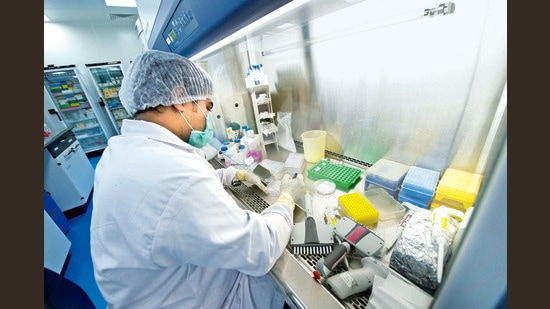Jul 12, 2024 09:19 PM IST
The vast majority of research done in India is fragmented and does not progress far enough to yield tangible benefits to patients
The relationship between investment in high-quality biomedical research, population health, and a country’s economic growth is well established. At no time in recent history has this link been appreciated better than during the Covid-19 pandemic. But unlike the shortened timelines during the pandemic, there is a long lag period between the time investments in research are made and benefits are observed. Therefore, policymakers are uncertain about the areas to which scarce funds should be diverted. Nevertheless, drawing on past national and global experiences, a few broad recommendations can be made.

In India, there is little money available for investment in health research. A decade ago, it was estimated that the funds received in research grants annually was about $200 million, nearly two-thirds of which came from the Union government. Assuming that investment has continued commensurate with Gross Domestic Product growth, the current figure is still likely to be less than half a billion dollars annually. For comparison, in the United States (US), public and institutional funding in health research is nearly $85 billion annually. From all sources, the US spends nearly $250 billion annually on biomedical research compared to about $1.4 billion by India. Therefore, for our research dollars to be competitive, we simply cannot allow any waste at all. How do we ensure this? A few simple principles can help. Most importantly, we should not fund “me-too” research purporting to generate “India-specific” data. For the majority of diseases that are of public health importance around the world, research done elsewhere is good enough to guide practice. In general, the development and progression of diseases, and their response to treatment vary little between populations. For the vast majority of diseases, clinical practice in India reflects this reality. Another category that should seldom be supported is projects that are far removed from clinical utility (unless there is a plausible path for further development, or it is student research). It would also be best to avoid funding research involving expensive treatments for common diseases. As a general rule, newer, more expensive technologies and treatments offer far less incremental benefit compared to the additional cost. A wiser use of money would be to focus on finding better ways to implement existing effective treatments.
Research is most useful when its design and focus allow for the results to be immediately deployed in the clinic or community. These are usually randomised clinical trials, focused on two broad categories of disease conditions. First, common diseases for which effective treatments are already available, and second, diseases that are disproportionately more prevalent in our country. For the first category, funding should be prioritised for trials that aim to find the best ways to implement already known effective treatments.
For diseases in the second category, effective treatments are often not available. These are generally diseases of poorer countries and are seldom the targets of serious research in the rich world. Supporting research to understand and treat such diseases would not only help our own population but also help people in other poor countries and serve as a testament to our scientific leadership.
In post-war US, there was a concerted push towards prioritising problem-solving, “strategic” or “translational” research over pure “curiosity-driven”, fundamental research. Proponents illustrated this by citing the work of Louis Pasteur (multidisciplinary, problem oriented research) over the “pure science” of Niels Bohr. Adopting an integrated, translation-oriented research template is widely believed to have contributed to the rapid strides in science and technology made by Japan in the decades after the war, and by China more recently.
In contrast, the vast majority of research done in India is fragmented and does not progress far enough to yield tangible benefits to patients. This is partly because of siloed institutional structures. Most often, basic scientists work on questions guided by their own understanding, without inputs from clinical scientists. Clinicians working in hospitals have neither the incentive nor the training to understand basic science research. As a result, the leads from basic research often die in the translational ‘valley of death’ as they fail to make the jump to a marketable product.
How can this situation be righted? The long-term solution perhaps lies in embedding medical schools within multi-disciplinary science campuses to foster the development of an interdisciplinary mindset. Meanwhile, research funds should preferentially be allocated to disease-focused, goal-oriented, multi-disciplinary, translational research with clear deliverables. (such as develop an effective, affordable medicine for drug-resistant TB).
The areas of priority should be identified by the public funding agency, guided by metrics such as the burden of disease in the population. The funds should preferentially be disbursed to teams consisting of basic scientists, clinicians and trialists, and industry partners. This would require funders to give out larger tranches of money to fewer research groups, unlike the current practice of giving small amounts of money to a large number of individual researchers. As the amount of money needed for mission-mode projects would be large, there should be an explicit mandate to secure co-funding from industry and other donors. It would encourage the reorganisation of academia and industry into virtual biomedical research clusters that would help streamline the process of translating fundamental science to health benefits for the population. As the central agencies fund most of the research, they have the power to nudge academia into reorganising, by preferentially funding multi-disciplinary teams to tackle the most important health problems facing the nation.
Karthikeyan is executive director of the Translational Health Science and Technology Institute, andprofessor of Cardiology at AIIMS, New Delhi.The views expressed are personal
Story Saved


